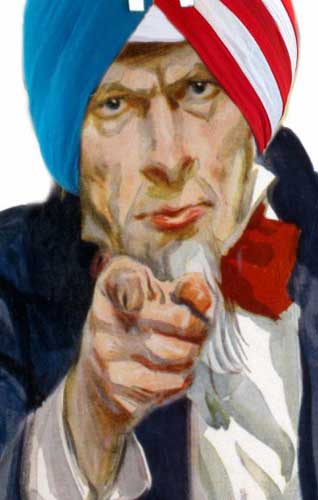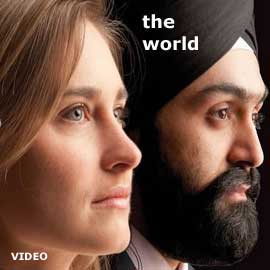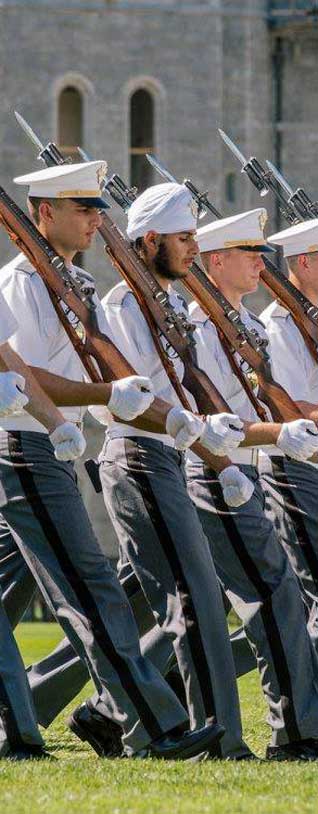Film/Stage
Sikhs In The US Army:
Harjus Singh’s New Documentary Film
‘Defense Directive’
MANSI MOTWANI
On January 3, 2017, then-Secretary of the US Army, Eric Fanning issued a directive (# 2017-03) which allowed Sikh soldiers serving in the United States Army to maintain their articles - the turban, unshorn hair and beard, etc - while serving on active duty.
The memorandum on religious accommodation in the American Army spelled victory not just for Sikh servicemen but for other ethnic and religious groups as well. As per the directive, African-Americans will be allowed to serve with dreadlocks and Muslims with hijabs.
The odyssey leading to this new policy, however, lasted nearly a decade and involved non-profit and civil rights groups, an international law firm and signatures of 15,000 people across the nation including congressmen and former military officials. As with any social change, it also involved a human catalyst - Lieutenant Colonel Kamaljeet ’Kamal’ Singh Kalsi.
The fourth-generation military man’s story starts in 2001. Kamal was in medical school and was recruited by the US Army through the Health Professionals Scholarship Program. With his training about to come to an end in 2008, he was getting ready to be deployed as an Army doctor when he received startling news from his commanding officers; despite earlier assurances, Kamal would not be allowed to keep his beard and turban intact while serving on full time, active duty.
He immediately petitioned the Army to grant him a religious accommodation.
“I spent a year and a half of my life on that,” he says, recalling how complicated it was for him to go up the chain of command. “It took six civil rights groups, a major law firm, 15,000 petitioners and half-a- million dollars of lobbying just to get me in. Policy work is very convoluted, and it took a lot of political strength. We had letters from military generals and senators that supported our stand, which helped us create a lot of dialogue. Finally, we were able to start talking with the
decision makers at the Pentagon.”
In October 2009, Kamal Singh Kalsi became the first Sikh in a generation to be allowed to serve in the US Army with his articles of faith.
“The following year after I got in, we had two more Sikh soldiers receive the accommodation. Before long, there were seven of us. Now, after the policy change, there are over 40 of us!” he adds excitedly.
In addition to having a notable presence in armed forces around the world, including India, Britiain, South-East Asia, and East Africa, Sikhs have been serving in the United States Army since World War I.
Talking about the Sikhi commitment to service, Kamal says, “My father and grandfather both served in the Indian Air Force. My great-grandfather served in the Royal British Army before the subcontinent gained independence and India and Pakistan were minted. Service is in our blood. It has become more than a spiritual practice for us.”
It was in 1981 that then-Secretary of Defense Caspar Weinberger, under the Ronald Reagan administration, rolled back the American Army’s 23-year- old policy that granted religious exceptions to its standards of appearance.
The SikhLens Foundation led by Sardar Bicky Singh is documenting the story of the journey leading up to this policy change. Titled ‘Defense Directive’, the documentary is being directed by Harjus Singh, a graduate from Chapman University’s Dodge Film school holding a Master’s degree in Film Directing. The feature-length documentary still in the making aspires to find a place in the catalogue of today’s video-streaming giants like Netflix and Amazon Video.
SikhLens is currently involved in fundraising efforts for the same. The goal is to collect $250,000, which would be used for filming interviews across the country, the film’s editing and post production process and marketing the documentary to tier-1 film festivals like Sundance, Cannes, the Toronto International Film Festival (TIFF).
Anybody willing to contribute to this endeavor may visit sikhlens.com/donate and add 'Defense Directive’ in the comments section on the donation page.
“The documentary will narrate how we have made progressive change in one of our oldest and most revered institutions - the US Army,” says Kamal Singh, continuing: “It basically talks about the journey of how the accommodation happened, how we were able to change the policy, the challenges we faced, along with stories of some of the Sikh soldiers who currently serve.”
One of the objections that the Army had with beards was the purported difficulty in the wearing of gas masks by soldiers in the event of a potential chemical-weapons attack. According to them, the facial hair of Sikh soldiers would prevent them from getting a tight grip on the masks around their face.
The documentary addresses the gas-mask issue headlong, among other objections raised by the Army and shows how these challenges were solved by those advocating for religious accommodation.
For filmmaker Harjus Singh, however, something supersedes the issue of Sikhs in the Army. Albeit the issue forms the core of the documentary, but “the larger implication” in his words, is about American identity and “how we see ourselves as a country.”
He says: “A concept that keeps coming up in the Army is ‘unit cohesion.’ Understandably, they have a strict uniform, similar to a lot of organisations including the police forces. A uniform unites people for sure. My question is, what does unite the people in the Army? Is it something as superficial as appearances, or can it be shared values? Because what they’ve kind of said is that if you have a turban and beard, you can’t be cohesive with the other people in the military. In many ways, they are excluding certain religions. And so, instead of saying let Sikhs into the Army, I am actually really trying to find the issue, that what about religious articles of faith like turbans and hijabs is so egregious that makes the person wearing them not fit in?”
After receiving his accommodation in 2009, then Major Kamal Singh Kalsi deployed to Afghanistan in 2011 as an emergency medicine physician, for which he received the Bronze Star Medal, the fourth-highest combat award in the U.S Armed Forces. According to Kamal’s superiors, he revived back to life two patients who were clinically dead on arrival and provided expert emergency care to more than 750 soldiers and civilians.
“Kamal saved lives of people who didn’t care that he had a turban and beard, all that mattered was he could save their lives!”, says Harjus Singh. “Some of them weren’t even conscious, having no recollection whatsoever of what he looked like. And afterwards, do you really care? If you’re able to breathe, you don’t! It should all be about how well a person can do his job.”
Speaking of his deployment days, Kamal recollects, “One of my comrades one day said to me, ‘dude, I don’t even see your turban and beard anymore. I just see a soldier wearing the same uniform and the same flag that’s on my arm.’ That’s all that matters.”
Harjus Singh has always been inspired by Sikh history, which he claims gives him a lot of strength, and is one of the reasons he agreed to spearhead this documentary. He reveres Guru Tegh Bahadar, the Ninth Master, for defending all people’s right to practice the faith of their choice, unhindered. Guru Sahib sacrificed his life to protect the right of Hindus under siege by the Islamic rulers of the day to practice their religion freely, even though most Hindu practices are anathema to Sikhi.
“I often wonder, can I call myself a Sikh without willing to defend other people’s freedom?” he says, adding that the ramifications arising out of the change in policy would not be limited to the Army alone. “If the military were a private corporation, it would be the second-largest company in the United States, employing 1.4 million servicemen and civilians altogether. When you have the second largest employer discriminating, the same policy could be adopted by other organisations. We have seen examples of police forces citing the military. When you’re able to change the policy in one branch of the government, it’s going to spread out into the others. For me, what could be more GurSikhi jeevan than helping other people? That’s what Guru Tegh Bahadar did until his last breath.”
‘Defense Directive’ features interviews of influential personalities involved in the United States’ policy-making process like Congressmen, Senators and Pentagon lawyers. So far Harjus has interviewed Eric Fanning and Alex Wagner, the Secretary and Undersecretary of the Army (under Barack Obama’s administration). He interviewed Pentagon lawyer Rob Park, as well as the lawyer for the Department of Defense. Also Senator Tim Kaine who, according to him was “very knowledgeable about this issue.”
He explains: “We spoke about ethnocentricity, about what an American looks like. He was one of the people that helped me shape the larger aspect of this documentary. It was after speaking to him I realised that in many ways, the moral victory of Sikhs in the Army is something that affects all of America. It really shows that we aren’t this, we can be different and yet united. It made me think that if America was an armed unit, could we be cohesive despite looking different?”
Both, Kamal and Harjus want the documentary to permeate beyond the Sikh community, to multicultural populations both within and outside the United States.
“It would be a huge failure if the documentary is only seen by the Sikh community,” says the Lieutenant Colonel.
Harjus adds: “We are shooting the documentary precisely according to Netflix and Amazon Video’s technical specifications for it to have a global audience. I want people to understand the struggle of what it’s like when a person wants to dedicate their life to something, but is expected to give up on his or her faith. Can a person look at someone with a turban and beard and just see the eyes and connect to that person, understand his struggles? I want people to connect emotionally to the Sikh on-screen. That’s the power of film; not only does it open people up intellectually, but it also opens their emotions up.”
In Army directive 2017-03, then-Secretary Eric Fanning mandated the Army’s brigade-level commanders to grant religious accommodations to those seeking it, unless the commander determines that a soldier is not sincere in his/her religious belief or recognises a specific, concrete hazard arising out of the accommodation. With this documentary, Kamal continues his fight for Sikhs to be able to serve freely.
On how satisfied he is with Army directive 2017-03, he says, “I give it a 9 out of 10. Practicing Sikhs are still unable to serve freely in the Air Force, the Marine Corps, the Navy and the Coast Guard, even in the US Public Health Services. The accommodation process has been simplified to a great extent, which is wonderful, but in an ideal world, my son or daughter would be able to show up at the recruiter’s office and join just like any other American instead of having to apply for an accommodation.”
According to Harjus, the work is far from over.
“This isn’t a law,” he says, “this is just policy. The thing about policy is, the next administration can take it away. We are in a very precarious spot.”
Ask him what he thinks an American looks like, and he says, “To me, an American looks like nobody, and yet looks like everybody at the same time.”
January 16, 2018




